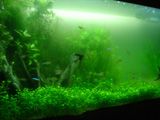Greenish? Likely 'green water' then.
http /www.theplantedtank.co.uk/algae.htm
/www.theplantedtank.co.uk/algae.htm
[SIZE=large]Green Water[/SIZE]

Description This is a unicellular algae. Water goes cloudy. Sometimes just a green tint, other times it can look like pea soup.
Cause Ammonia is often the main cause green water. There may have been an ammonia spike that isn't detected with test kits. Other possible causes are an imbalance of nutrients and/or low CO2 levels.
Removal Large water changes do not seem to always help. If there is an imbalance in nutrients then fixing it will sometimes make it go away by itself after a while. A three day blackout followed by a large water change will hit it hard and sometimes may clear it. A UV steriliser/clarifier or diatom filter will clear it up very quickly and is often the only way to clear it.
A new method is to use freshly cut 1-2 year old willow branches about 0.5-1cm in width. Place these in your tank vertically so they go from the substrate to a few centimetres above the water's surface. After a few days they will start to grow roots and the green water should start to clear. When cleared remove the branches from the water.
Don't confuse this with a bacterial bloom which gives the water a white haze.
I'd suggest going the blackout route. You are likely dealing with the bolded section as the primary cause.
http
 /www.theplantedtank.co.uk/algae.htm
/www.theplantedtank.co.uk/algae.htm[SIZE=large]Green Water[/SIZE]


Description This is a unicellular algae. Water goes cloudy. Sometimes just a green tint, other times it can look like pea soup.
Cause Ammonia is often the main cause green water. There may have been an ammonia spike that isn't detected with test kits. Other possible causes are an imbalance of nutrients and/or low CO2 levels.
Removal Large water changes do not seem to always help. If there is an imbalance in nutrients then fixing it will sometimes make it go away by itself after a while. A three day blackout followed by a large water change will hit it hard and sometimes may clear it. A UV steriliser/clarifier or diatom filter will clear it up very quickly and is often the only way to clear it.
A new method is to use freshly cut 1-2 year old willow branches about 0.5-1cm in width. Place these in your tank vertically so they go from the substrate to a few centimetres above the water's surface. After a few days they will start to grow roots and the green water should start to clear. When cleared remove the branches from the water.
Don't confuse this with a bacterial bloom which gives the water a white haze.
I'd suggest going the blackout route. You are likely dealing with the bolded section as the primary cause.

